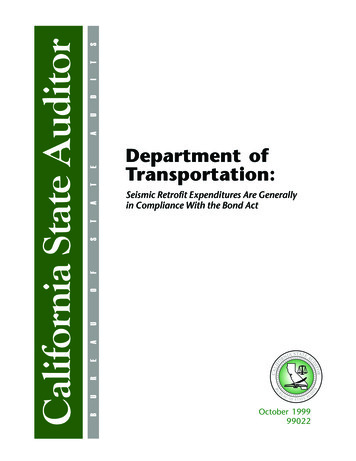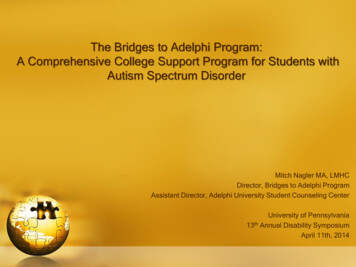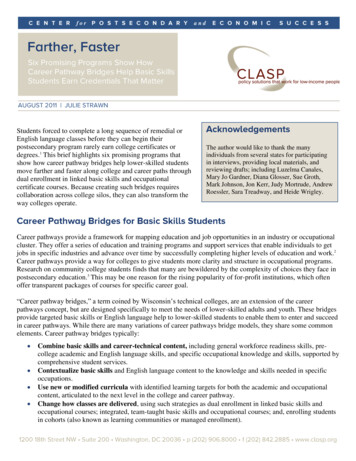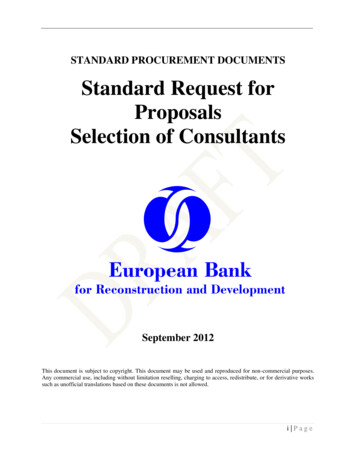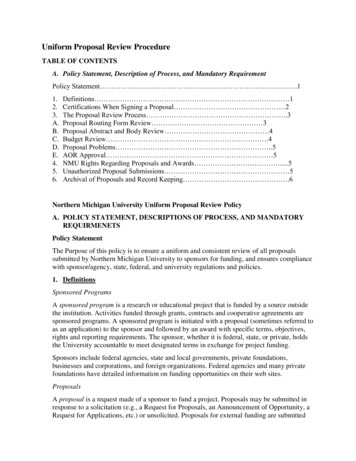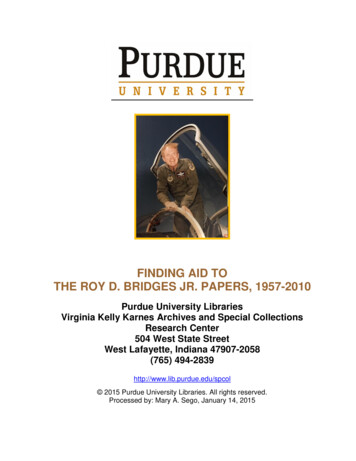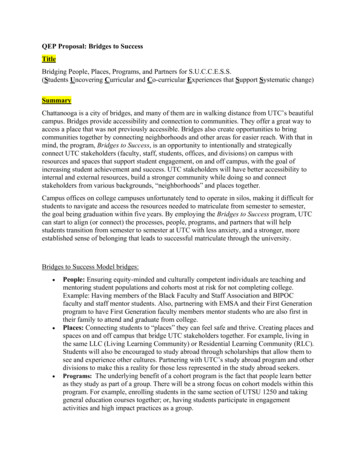
Transcription
QEP Proposal: Bridges to SuccessTitleBridging People, Places, Programs, and Partners for S.U.C.C.E.S.S.(Students Uncovering Curricular and Co-curricular Experiences that Support Systematic change)SummaryChattanooga is a city of bridges, and many of them are in walking distance from UTC’s beautifulcampus. Bridges provide accessibility and connection to communities. They offer a great way toaccess a place that was not previously accessible. Bridges also create opportunities to bringcommunities together by connecting neighborhoods and other areas for easier reach. With that inmind, the program, Bridges to Success, is an opportunity to intentionally and strategicallyconnect UTC stakeholders (faculty, staff, students, offices, and divisions) on campus withresources and spaces that support student engagement, on and off campus, with the goal ofincreasing student achievement and success. UTC stakeholders will have better accessibility tointernal and external resources, build a stronger community while doing so and connectstakeholders from various backgrounds, “neighborhoods” and places together.Campus offices on college campuses unfortunately tend to operate in silos, making it difficult forstudents to navigate and access the resources needed to matriculate from semester to semester,the goal being graduation within five years. By employing the Bridges to Success program, UTCcan start to align (or connect) the processes, people, programs, and partners that will helpstudents transition from semester to semester at UTC with less anxiety, and a stronger, moreestablished sense of belonging that leads to successful matriculate through the university.Bridges to Success Model bridges: People: Ensuring equity-minded and culturally competent individuals are teaching andmentoring student populations and cohorts most at risk for not completing college.Example: Having members of the Black Faculty and Staff Association and BIPOCfaculty and staff mentor students. Also, partnering with EMSA and their First Generationprogram to have First Generation faculty members mentor students who are also first intheir family to attend and graduate from college.Places: Connecting students to “places” they can feel safe and thrive. Creating places andspaces on and off campus that bridge UTC stakeholders together. For example, living inthe same LLC (Living Learning Community) or Residential Learning Community (RLC).Students will also be encouraged to study abroad through scholarships that allow them tosee and experience other cultures. Partnering with UTC’s study abroad program and otherdivisions to make this a reality for those less represented in the study abroad seekers.Programs: The underlying benefit of a cohort program is the fact that people learn betteras they study as part of a group. There will be a strong focus on cohort models within thisprogram. For example, enrolling students in the same section of UTSU 1250 and takinggeneral education courses together; or, having students participate in engagementactivities and high impact practices as a group.
Partners: Creating and enhancing on and off campus partnerships that provideopportunities like internships/externships; partnering with research programs, such asURaCE (Undergraduate Research and Creative Endeavors), to provide students fromunderrepresented populations research opportunities. Community partners could providefellowships with city government, nonprofit organizations that support civic engagement.Rationale/Problem Statement/Growth Opportunity - Describe why this concept is importantto UTC at this time, and how our students and the overall institutional will benefit from theproposed plan. You could include relevant data here (quantitative, qualitative, or experiential).Clearly demonstrate the connection to cohorts, collaborative learning, and diversity, asappropriate.UTC’s graduation rate is currently 50% and its current retention rate is 73% (down 5% since thepandemic). While the community around the institution is getting increasingly diverse, theinstitution is not. Its student and faculty populations do not mirror the diversity the community inwhich the institution sits. There is abundant opportunity for UTC to increase student success andprovide meaningful and diverse opportunities that allows the campus community to grow andbecome competitive in this globally diverse society.UTC is uniquely positioned to support first generation college students and those students whoreside in underserved communities throughout the state of Tennessee. As college campusesbecome more diverse regarding ethnic background, age, and lived experiences, it is imperative toensure that college campuses are equipped to meet the needs of the whole student. Education canserve as a vehicle for economic and social mobility, in addition to better health outcomes.College campuses provide students multiple opportunities to be exposed to and exploreendeavors that connect them to research ventures, studying abroad, active communityengagement, and professional development. In addition, general education and core curriculumfor majors allows students to broaden their knowledge of liberal arts education. Theseexperiences increase students' confidence, self-efficacy, and ability to effectively engage withdiverse populations. Ultimately, these experiences coupled with strategic programming centeredon the development, implementation, and assessment of cohort-based programs that focus ondiversity, cultural humility, and multiculturalism.Success for college students, particularly for students of color, is challenging. Moving towardsinstitutional action is needed to change the current landscape for students of color (Tinto, 2012)Institutions must be designed for student success. Given that demographics of today’s student ischanging, colleges and universities should consider new and better ways to effectively supporttheir students on the path to graduation. Students are working more than they ever have tosupport their families. Veteran populations on campus are growing. UTC has seen an increase inthe number of LatinX students. As students with diverse and varied backgrounds are becomingthe norm, the traditional support system typically found on campuses, will eventually beinsufficient.As outlined in UTC’s strategic plan (to be approved October 2021), student success ishighlighted as a goal. UTC aims to improve student performance and
1) Increase first-year fall-to-fall retention from 73% to 83%2) Reduce achievement and learning gaps3) Increase six-year graduation rate from 50% to 63.7%The Bridges to Success program could serve as a catalyst that allows the University to reset andrethink the way it operates and encourages more divisions to work together for one commongoal: improving the success rates of our students.Expected Outcomes/Impact on Student Learning or the Learning Environment-Describethe impact of this concept on student learning and success and explain the expected outcomes interms of student knowledge, skills, attitudes, values, or behaviors. How will UTC befundamentally different and better when your concept QEP is implemented?The impact of this concept on student learning and success will be dependent on the coordinationof multiple offices and divisions across the campus. As a result of this concept, expectedoutcomes will include: Enhancement and utilization of current UTC resourcesRemoving overt and covert barriers to student successTransforming learning environments to be more inclusive and equitableBuilding a community of active research and engagement for diverse studentsIncreasing recruitment and retention of BILPOC and those from historically resilient andunderserved areasDeveloping a comprehensive, integrated, and holistic approach to student successApplication of clear pathways for student learning, success, and pivotingUtilizing best practices and high-impact practices (HIPs), BRIDGES will be different in itsability to track, monitor, and provide intentional pathways from high school to completion of a4-year degree at UTC. Students will increase their sense of belonging by intentionally recruitingthose identified students during their formative years in high school. University High, a newinitiative could be one avenue to support students by engaging students in more meaningful waysto address: Understanding students' individual stories and lived experiencesUnderstanding students “why”- for pursuing college, choosing a majorDeveloping deeper strategies to address the whole student that addresses their preciseneeds with purposeful collaboration that builds trust and connectivity throughout thecampus and communityDeveloping a holistic advising approach that addresses the "5 P's": people, place, person,purpose, and populationo People refers to a core group of individuals (e.g. family, friends, mentors,coaches) that will support them in their journey.o Place refers to helping students think critically about the type of workenvironment they want to pursue (e.g. school, community, clinical setting,traveling, etc.).
oooPerson refers to students thinking about the types of responsibilities they want tohold in their profession (leader, team-players, working alone).Purpose allows students to consider the unique skills, talents, and gifts they canshare with the world.Population refers to the specific groups of people that students desire to serve(e.g., athletes, school-age children, older adults, etc.).Strategies/Actions to be implemented-Describe how this concept would be implemented toimprove student learning or student success. What steps or actions are needed?The first year of implementation is the most critical. That is why we propose to use the spirit of acollective impact model to launch implementation for this program. Broadly defined, CollectiveImpact is an approach to social challenges (and in UTC’s case, institutional challenges) that aretoo complex for one organization (or campus division) to address on its own.Through UTC’s collective impact process, multiple units will work together to achieve twogoals: 1) increasing our institution’s graduation rates and 2) increasing UTC’s retention rates.Chattanooga 2.0 is a notable example of our city’s collective impact model in which UTC is apartner. We will benchmark our process to implementation closely to the Collective ImpactModel with our UTC community and Greater Chattanooga community as partners. A toolkit forimplementation can be found here. Keep in mind that we are trying to solve institutionalchallenges—those that impact our students, faculty, and staff.Collaborative action almost always begins with the establishment of an oversight group, oftencalled a steering committee or executive committee. The main key structural components ofUTC’s collective impact approach will be the creation of a steering committee, workinggroups, backbone support, and campus and community engagement.Here are examples of committees, key champions and programs that could result from UTC’s“collective impact” model for Bridges to Success. On campus and off campus champions (i.e.,UTC’s ELT members, CEOs, philanthropists)Advisory Council which will include but not limited to high school studentrepresentatives, high school guidance/career counselors, community stakeholders(business, industry, non-profit, etc.). UTC staff: admissions, financial aid andscholarships, Mocs One Center, student success program, Center for Global Education,health services, academic outreach, career services, housing, and academic support andadvising.Establishment of BRIDGE Pathway Program:o Sample source: EAB Barriers to Equity in SuccessEstablishment of University Alliance of Innovation and CollaborationHiring of staff:o Executive Director of programo Coordinators (communications & administrative/logistics)
Students- Identify which students will be impacted by this concept. For example: undergraduatestudents, graduate students, full-time first-year students, all first-year students, etc. Note: Theprograms that the QEP supports does not intend to impact every student directly, but it does needto offer a significant enhancement to student learning at UTC by using the cohort model forgreatest impact. However, the collective impact model, by its very nature, intends to shiftcultures and systems over time so that impact reaches more audiences.The following cohorts could be impacted by this program concept and process model: Undergraduate studentsFirst-time full-time first-year studentStudents from historically resilient backgroundsStudents from underserved geographic areasFirst generation studentsCoordinating pathways for students in the identified groups will also provide guidedpathways for other student groups. This requires coordination of culture, communication,community, collaboration, and celebration (Inside Higher Ed, 2019).Assessment - Describe how this concept would be implemented to improve student learning orstudent success. What steps or actions are needed? Align concept with UTC strategic plan, mission, and vision of the UniversityCompletion of Needs AssessmentDevelop an Assessment StrategyIdentify benchmarks and baseline for student success based on the following parameters:o Recruitment of students to UTCo Retention of students from first year to second year at UTCo Retention of students from second year to third year at UTCo Retention of students from third year to fourth year at UTCo Grade point average of 2.75 or highero Utilization of services and resources at UTC (advising, academic experience,college navigation)Determine criteria for successIdentify outcomes, curriculum pathway mappingSelect methods and conduct assessment for data collection: surveys, focus groups,interviewsAnalyze and interpret resultsProposed action plan/improvement planResources Needed-Describe resources necessary to implement this concept successfully. Adetailed budget is not required at this time, but if possible, include needed staff, physical space,software, etc. 2-3 staff memberso 1 Executive Director of programo 2 Coordinators (communications & administrative/logistics)Physical spaceo 2-3 Offices and possible space for student workers/volunteers
RLC (Residential Learning Community) or LLC (Living Learning Community)Faculty or Staff in ResidenceStipends for University leaders who would assume responsibility for leading workinggroups (we do not want faculty to take on additional responsibilities without fairconsideration of their time spent in class and working on this initiative)Financial resources for study abroad for 20-25 students and multiple UTC representativesFinancial resources for cultural immersion experiences throughout the academic yearResearch/Best Practices Gathered to Date- Describe any research, data, or best practices thatyou have found thus far in thinking about your concept. Is your concept novel, based on anothermodel, or based on your own research?An assessment and data plan will include the following: The Healthy Campus FrameworkThe Collective Impact Community ToolboxNational Institute for Student SuccessData analysis, collection, and storytelling (UTC OPEIR and Hominumero)Specialized programs like the University of Central Florida: University InnovationAlliance, “which develops and shares innovative solutions that help students overcomebarriers to success in earning their degree.”Tennessee Service-Learning Consortium: UTC is currently not a memberBlack First-Generation College Students Matter: A Call to ActionReferences:Tinto, V. (2012). Completing college: Rethinking institutional action. University of ChicagoPress.
QEP Proposal: Bridges to Success Title Bridging People, Places, Programs, and Partners for S.U.C.C.E.S.S. (Students Uncovering Curricular and Co-curricular Experiences that Support Systematic change) Summary Chattanooga is a city of bridges, and many of them are in walking distance from UTC's beautiful campus.


